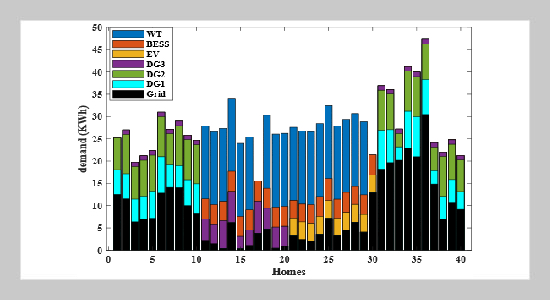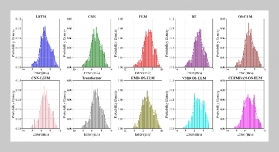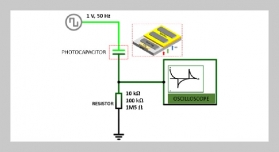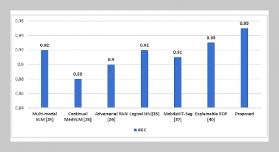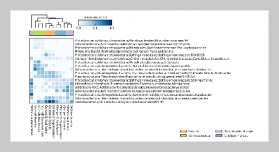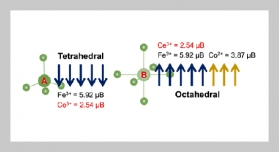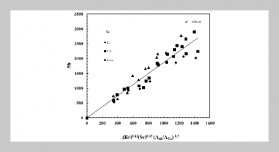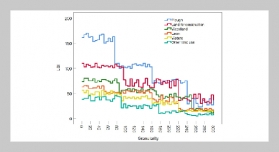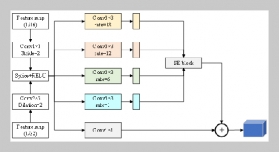- [1] L. Lv, Z. Fang, Z. Yang, L. Wu, and Y. Yang, (2024) “Stability Study of Grid-Connected Power System for Wind Farms Considering Power Control" Scalable Computing: Practice and Experience 25: 700–708. DOI: https: //doi.org/10.12694/scpe.v25i2.2543.
- [2] B. Sobhani and S. Afzal, (2022) “Combinatorial price offer for a wind turbine with flexible load considering the uncertainty to increase the benefit of wind turbine" Advances in Engineering and Intelligence Systems 1: 13–21. DOI: https: //doi.org/10.22034/aeis.2022.147971.
- [3] A. Niknami, M. T. Askari, M. A. Ahmadi, M. B. Nik, and M. S. Moghaddam, (2024) “Resilient day-ahead microgrid energy management with uncertain demand, EVs, storage, and renewables" Cleaner Engineering and Technology 20: 100763. DOI: https: //doi.org/10.1016/j.clet.2024.100763.
- [4] W.-C. Tsai, C. -M. Hong, C.-S. Tu, W. -M. Lin, and C. -H. Chen,(2023) “Areviewofmodernwindpowergeneration forecasting technologies" Sustainability 15: 10757. DOI: https: //doi.org/10.3390/su151410757.
- [5] W. Liu, Y. Liu, S. Li, and Y. Chen, (2023) “A review of variational mode decomposition in seismic data analysis" Surveys in Geophysics 44: 323–355. DOI: https: //doi.org/10.1007/s10712-022-09742-z.
- [6] Z.MaandG.Mei,(2022)“Ahybridattention-baseddeep learning approach for wind power prediction" Applied Energy 323: 119608. DOI: https: //doi.org/10.1016/j.apenergy.2022.119608.
- [7] K. Ullah, A. Basit, Z. Ullah, F. R. Albogamy, and G. Hafeez, (2022) “Automatic generation control in modern power systems with wind power and electric vehicles" Energies 15: 1771. DOI: https: //doi.org/10.3390/en15051771.
- [8] M. M. Islam, T. Yu, G. Giannoccaro, Y. Mi, M. L. Scala, M. N.Rajabi, and J. Wang, (2024) “Improving reliability and stability of the power systems: A comprehensive review on the role of energy storage systems to enhance flexibility" IEEE Access: DOI: http: //dx.doi.org/10.1109/ACCESS.2024.3476959.
- [9] P. Lu, N. Zhang, L. Ye, E. Du, and C. Kang, (2024) “Advances in model predictive control for large-scale wind power integration in power systems" Advances in Ap plied Energy 14: 100177. DOI: https: //doi.org/10.1016/j.adapen.2024.100177.
- [10] W.-c. Wang, B. Wang, K.-w. Chau, and D.-m. Xu, (2023) “Monthly runoff time series interval prediction based on WOA-VMD-LSTM using non-parametric kernel density estimation" Earth Science Informatics 16: 2373–2389. DOI: https: //doi.org/10.1007/s12145-023-01038-z.
- [11] L. Ali, M. M. Al-Sakhnini, D. Kalra, F. Afzaal, M. Pervaiz, and M. F. Khan. “Distributed search engine query optimization using artificial neural network”. In: 2022 International Conference on Cyber Resilience (ICCR). IEEE, 2022, 1–5. DOI: https: //doi.org/10.1109/iccr56254.2022.9995958.
- [12] Z. Sun, M. Zhao, and G. Zhao, (2022) “Hybrid model based on VMD decomposition, clustering analysis, long short memory network, ensemble learning and error complementation for short-term wind speed forecasting assisted by Flink platform" Energy 261: 125248. DOI: https: //doi.org/10.1016/j.energy.2022.125248.
- [13] V. K. Saini, R. Kumar, A. S. Al-Sumaiti, and E. Heydarian-Forushani, (2023) “Learning based short term wind speed forecasting models for smart grid applications: An extensive review and case study" Electric Power Systems Research 222: 109502. DOI: https: //doi.org/10.1016/j.epsr.2023.109502.
- [14] Y. Du, K. Zhang, Q. Shao, and Z. Chen, (2023) “A short-term prediction model of wind power with outliers: An integration of long short-term memory, ensemble empirical mode decomposition, and sample entropy" Sustainability 15: 6285. DOI: https: //doi.org/10.3390/su15076285.
- [15] L. Zhao, Z. Li, J. Zhang, and B. Teng, (2023) “An integrated complete ensemble empirical mode decomposition with adaptive noise to optimize LSTM for significant wave height forecasting" Journal of Marine Science and Engineering 11: 435. DOI: https: //doi.org/10.3390/jmse11020435.
- [16] Z. Liu, S. Zhang, X. Shao, and Z. Wu, (2023) “Ac curate and efficient urban wind prediction at city-scale with memory-scalable graph neural network" Sustain able Cities and Society 99: 104935. DOI: https: //doi.org/10.1016/j.scs.2023.104935.
- [17] E. Ghanbari and A. Avar, (2025) “Short-term wind power forecasting using the hybrid model of multivariate variational mode decomposition (MVMD) and long short-term memory (LSTM) neural networks" Electrical Engineering 107: 2903–2933. DOI: https: //doi.org/10.1007/s00202-024-02685-1.
- [18] H. Hu, S. Deng, W. Yan, Y. He, and Y. Wu, (2024) “Prediction of operational noise uncertainty in automotive micro-motors based on multi-branch channel–spatial adaptive weighting strategy" Electronics 13: 2553. DOI: https: //doi.org/10.3390/electronics13132553.
- [19] Z. Jiang, Q. Tan, N. Li, J. Che, and X. Tan, (2024) “A novel BiGRU multi-step wind power forecasting approach based on multi-label integration random forest feature selection and neural network clustering" Energy Con version and Management 319: 118904. DOI: https: //doi.org/10.1016/j.enconman.2024.118904.
- [20] U. Yuzgec, E. Dokur, and M. Balci, (2024) “A novel hybrid model based on empirical mode decomposition and echo state network for wind power forecasting" Energy 300: 131546. DOI: https: //doi.org/10.1016/j.energy.2024.131546.
- [21] J.K.ParkerandL.O.Hall,(2013)“Accelerating fuzzy-c means using an estimated subsample size" IEEE Trans actions on Fuzzy Systems 22: 1229–1244. DOI: https: //doi.org/10.1109/TFUZZ.2013.2286993.
- [22] M. M. Romadanova. “Wind velocity data interpolation using a weighted cubic spline”. In: E3S Web of Conferences. 402. EDP Sciences, 2023, 05011. DOI: https: //doi.org/10.1051/e3sconf/202340205011.
- [23] O. Abedinia, M. Lotfi, M. Bagheri, B. Sobhani, M. Shafie-Khah, and J. P. S. Catalão, (2020) “Improved EMD-based complex prediction model for wind power forecasting" IEEE Transactions on Sustainable Energy 11: 2790–2802. DOI: https: //doi.org/10.1109/TSTE.2020.2976038.
- [24] K. Dragomiretskiy and D. Zosso, (2013) “Variational mode decomposition" IEEE transactions on signal pro cessing 62: 531–544. DOI: https: //doi.org/10.1109/TSP.2013.2288675.
- [25] C. Gao, T. Tang, W. Wu, F. Zhang, Y. Luo, W. Wu, B. Yao, and J. Li, (2023) “Hyperspectral prediction model of nitrogen content in citrus leaves based on the CEEM DAN–SRalgorithm" Remote Sensing 15: 5013. DOI: https: //doi.org/10.3390/rs15205013.
- [26] J. P. Muszkats, S. A. Seminara, and M. I. Tro parevsky. Applications of wavelet multiresolution anal ysis. Springer, 2021. DOI: https: //doi.org/10.1007/978-3-030-61713-4.
- [27] D. Sundararajan. Discrete wavelet transform: a signal processing approach. John Wiley Sons, 2016.
- [28] D. Sundararajan. Signals and Systems.
- [29] J. Xu, J. Du, and C. Yuan, (2024) “An alternative 2D ICEEMDAN-based denoising method and its application in processing magnetic anomaly data" Geodesy and Geodynamics 15: 465–476. DOI: https: //doi.org/10.1016/j.geog.2024.04.002.
- [30] P.Flandrin,P.Gonçalvès,andG.Rilling,(2005)“EMD EQUIVALENTFILTERBANKS,FROMINTERPRETA TION TO APPLICATIONS" Hilbert-Huang Trans form and Its Applications: 57–74. DOI: https: //doi.org/10.1142/8804.
- [31] J. Xu, J. Du, and C. Yuan, (2024) “An alternative 2D ICEEMDAN-based denoising method and its application in processing magnetic anomaly data" Geodesy and Geodynamics 15: 465–476. DOI: https: //doi.org/10.1016/j.geog.2024.04.002.
- [32] T. Zhang, Y. Huang, B. Gu, H. Liao, and C. Song, “Short-Term Forecasting and Uncertainty Analysis for Wind Power Generation Based on Hybrid Deep Learning and Cloud Model" Available at SSRN 3900344: DOI: https: //dx.doi.org/10.2139/ssrn.3900344.
- [33] T. Zhang, Y. Huang, H. Liao, X. Gong, and B. Peng, (2024) “Short-term power forecasting and uncertainty analysis of wind farm at multiple time scales" Ieee Access 12: 25129–25145. DOI: https: //doi.org/10.1109/ACCESS.2024.3365493.
- [34] T. Zhang, Y. Huang, H. Liao, X. Gong, and B. Peng, (2024) “Short-term power forecasting and uncertainty analysis of wind farm at multiple time scales" Ieee Access 12: 25129–25145. DOI: https: //doi.org/10.1109/ACCESS.2024.3365493.
- [35] M. Ali, D. M. Khan, I. Saeed, and H. M. Alshanbari, (2023) “A new approach to empirical mode decomposition based on akimaspline interpolation technique" IEEE Ac cess 11: 67370–67384. DOI: http: //dx.doi.org/10.1109/ACCESS.2023.3253279.
